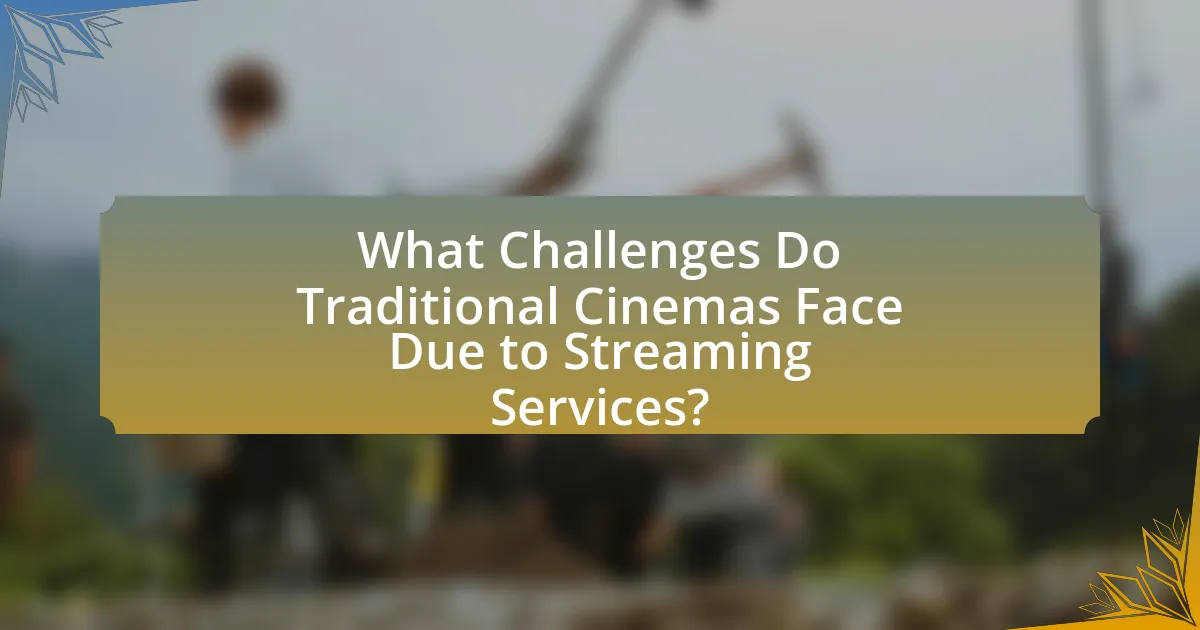Streaming services are digital platforms that enable real-time access to audio and video content over the internet, significantly transforming media consumption since their emergence in the early 2000s. The article explores the factors contributing to the rise of these services, including advancements in internet technology and changing consumer behavior, particularly during the COVID-19 pandemic. It examines how streaming platforms have altered film distribution, marketing strategies, and audience engagement, while also highlighting the challenges faced by traditional cinemas, such as declining ticket sales and revenue. Additionally, the article discusses the evolving relationship between streaming services and cinemas, potential future trends, and innovations that could reshape the film industry landscape.

What are Streaming Services and How Have They Emerged?
Streaming services are digital platforms that allow users to access and consume audio and video content over the internet in real-time without the need for downloading. They have emerged significantly since the early 2000s, driven by advancements in internet technology, increased broadband availability, and the proliferation of smart devices. The launch of platforms like Netflix in 2007, which transitioned from DVD rentals to streaming, marked a pivotal moment in this evolution. By 2020, Netflix had over 200 million subscribers globally, illustrating the rapid adoption of streaming services. This shift has transformed media consumption habits, leading to a decline in traditional cinema attendance and altering the landscape of content distribution and production.
What factors contributed to the rise of streaming services?
The rise of streaming services was primarily driven by advancements in internet technology, changing consumer behavior, and the demand for on-demand content. High-speed internet access allowed for seamless streaming experiences, while consumers increasingly preferred the convenience of watching content anytime and anywhere. According to a report by Deloitte, 61% of U.S. consumers preferred streaming services over traditional cable in 2020, highlighting a significant shift in viewing habits. Additionally, the COVID-19 pandemic accelerated this trend, as lockdowns led to a surge in subscriptions, with platforms like Netflix and Disney+ reporting millions of new users within months. These factors collectively contributed to the rapid growth and popularity of streaming services.
How has technology influenced the growth of streaming platforms?
Technology has significantly influenced the growth of streaming platforms by enabling high-speed internet access and advanced data compression techniques. The widespread availability of broadband internet has allowed users to stream content seamlessly, while innovations in data compression, such as H.265, have improved video quality without requiring excessive bandwidth. According to a report by Statista, the number of global streaming subscribers reached over 1.1 billion in 2021, reflecting the impact of these technological advancements on consumer behavior and platform accessibility. Additionally, the rise of smart devices, including smartphones and smart TVs, has further facilitated the consumption of streaming content, making it more convenient for users to access a variety of media anytime and anywhere.
What role did consumer behavior play in the adoption of streaming services?
Consumer behavior significantly influenced the adoption of streaming services by shifting preferences towards on-demand content and convenience. As consumers increasingly sought flexibility in viewing options, streaming platforms like Netflix and Hulu capitalized on this trend by offering extensive libraries accessible anytime and anywhere. Research from Deloitte in 2020 indicated that 70% of consumers preferred streaming services for their ability to provide personalized content recommendations, further driving adoption. This shift in consumer expectations led to a decline in traditional cable subscriptions, as viewers prioritized the ease and variety offered by streaming services over conventional viewing methods.
What are the key features of popular streaming services?
Key features of popular streaming services include a vast content library, subscription-based access, personalized recommendations, and multi-device compatibility. These services, such as Netflix and Amazon Prime Video, offer extensive selections of movies, TV shows, and original programming, catering to diverse viewer preferences. Subscription models provide users with ad-free experiences and the ability to binge-watch entire seasons. Advanced algorithms analyze user behavior to deliver tailored content suggestions, enhancing viewer engagement. Additionally, compatibility across various devices, including smartphones, tablets, smart TVs, and gaming consoles, allows for flexible viewing options, contributing to the convenience and accessibility that define modern streaming platforms.
How do subscription models differ among streaming platforms?
Subscription models among streaming platforms differ primarily in pricing structures, content access, and user experience. For instance, platforms like Netflix offer tiered pricing based on the number of simultaneous streams and video quality, while Disney+ provides a flat rate with access to its entire library, including exclusive content. Additionally, Amazon Prime Video combines its streaming service with other Amazon benefits, creating a bundled subscription model. These differences reflect varying strategies to attract and retain subscribers, with Netflix focusing on original content production, Disney+ leveraging its extensive catalog of franchises, and Amazon integrating streaming with e-commerce benefits.
What content offerings set streaming services apart from traditional cinema?
Streaming services differentiate themselves from traditional cinema primarily through their diverse content offerings, including original programming, on-demand access, and a vast library of titles. Unlike traditional cinema, which typically features a limited selection of films shown in theaters, streaming platforms like Netflix and Amazon Prime Video produce exclusive series and films that are not available elsewhere, attracting a broader audience. Additionally, streaming services provide viewers with the flexibility to watch content at their convenience, often featuring binge-worthy series and a wide range of genres, from documentaries to international films. This model contrasts sharply with the fixed schedules and limited availability of films in cinemas, making streaming services more appealing to modern audiences seeking variety and accessibility.

How Have Streaming Services Changed the Landscape of Cinema?
Streaming services have fundamentally transformed the landscape of cinema by shifting the distribution model from traditional theaters to on-demand viewing platforms. This change has democratized access to films, allowing audiences to watch a diverse range of content from the comfort of their homes, which has led to a decline in box office revenues for theaters. For instance, in 2020, the global box office revenue dropped by 71% due to the COVID-19 pandemic, while streaming subscriptions surged, with platforms like Netflix gaining over 36 million new subscribers in just the first half of that year. Additionally, streaming services have enabled the production of original content, with companies like Amazon and Hulu investing billions in exclusive films and series, thereby altering the competitive landscape and challenging traditional studios.
What impact do streaming services have on film distribution?
Streaming services significantly alter film distribution by enabling direct access to audiences, bypassing traditional theatrical releases. This shift allows filmmakers to reach global viewers instantly, as evidenced by platforms like Netflix and Amazon Prime, which have released films simultaneously in theaters and online. According to a 2021 report by the Motion Picture Association, streaming accounted for 80% of the U.S. film industry’s revenue growth, highlighting its dominance over conventional distribution methods. Additionally, streaming services often invest in original content, further reshaping the landscape by prioritizing diverse storytelling and niche genres that may not thrive in traditional cinemas.
How has the release strategy for films evolved with streaming services?
The release strategy for films has evolved significantly with the rise of streaming services, shifting from exclusive theatrical releases to simultaneous or early digital availability. Traditional cinema relied heavily on a windowed release model, where films would first premiere in theaters before being available for home viewing, often months later. However, platforms like Netflix and Amazon Prime Video have popularized the practice of releasing films directly to streaming, sometimes even on the same day as their theatrical debut, as seen with Netflix’s release of “The Irishman” in 2019. This change has been driven by consumer demand for immediate access to content and the need for studios to adapt to changing viewing habits, particularly during the COVID-19 pandemic, which accelerated the trend of hybrid releases. The shift has led to increased competition among studios and streaming platforms, fundamentally altering how films are marketed and consumed.
What are the implications for independent filmmakers in the streaming era?
Independent filmmakers face both opportunities and challenges in the streaming era. The rise of platforms like Netflix, Amazon Prime, and Hulu has democratized distribution, allowing independent films to reach global audiences without the need for traditional theatrical releases. This shift has led to increased visibility for diverse voices and unique storytelling, as streaming services often seek original content to differentiate themselves in a competitive market.
However, the implications also include heightened competition, as the influx of content can make it difficult for independent films to stand out. According to a 2021 report by the Motion Picture Association, streaming services accounted for 80% of the film industry’s revenue growth, indicating a crowded marketplace where independent filmmakers must invest in marketing and audience engagement strategies to capture viewer attention. Additionally, revenue models on streaming platforms often favor larger productions, which can limit financial returns for independent creators.
Overall, while the streaming era provides new avenues for distribution and audience reach, independent filmmakers must navigate a complex landscape characterized by both opportunity and competition.
How do streaming services affect audience engagement with films?
Streaming services significantly enhance audience engagement with films by providing on-demand access to a vast library of content. This accessibility allows viewers to watch films at their convenience, leading to increased viewing frequency and a broader exploration of diverse genres and international cinema. According to a 2021 report by Deloitte, 80% of consumers stated that they watch more films due to the availability of streaming platforms, highlighting a direct correlation between streaming access and film consumption. Additionally, features such as personalized recommendations and social sharing options further foster engagement, as they encourage viewers to discover new films and share their experiences with others.
What changes have occurred in viewing habits due to streaming services?
Streaming services have significantly altered viewing habits by promoting binge-watching and on-demand consumption. Viewers now prefer to watch entire seasons of shows in one sitting, a trend supported by a 2021 survey from Deloitte, which found that 70% of streaming subscribers engage in binge-watching. Additionally, the convenience of accessing content anytime and anywhere has led to a decline in traditional cable subscriptions, with a report from eMarketer indicating that U.S. pay-TV subscriptions dropped by 25% from 2015 to 2021. This shift reflects a broader cultural change towards personalized viewing experiences, where audiences prioritize flexibility and choice over scheduled programming.
How do streaming platforms influence film marketing strategies?
Streaming platforms significantly influence film marketing strategies by shifting focus from traditional advertising to digital engagement and targeted promotions. These platforms utilize data analytics to understand viewer preferences, allowing filmmakers to tailor marketing campaigns that resonate with specific audiences. For instance, Netflix employs algorithms to recommend films based on user behavior, which informs promotional strategies and enhances viewer engagement. Additionally, the rise of social media integration in marketing campaigns, driven by streaming services, enables real-time interaction and feedback, further refining marketing approaches. This data-driven strategy has been shown to increase viewer retention and drive subscriptions, as evidenced by Netflix’s reported growth in subscribers following targeted marketing efforts for original content.

What Challenges Do Traditional Cinemas Face Due to Streaming Services?
Traditional cinemas face significant challenges due to the rise of streaming services, primarily including decreased audience attendance and revenue loss. As streaming platforms like Netflix and Amazon Prime Video offer convenient access to a vast library of films from home, traditional cinemas struggle to attract viewers who prefer the comfort and affordability of at-home viewing. According to a 2021 report by the Motion Picture Association, global box office revenue fell by 72% in 2020 due to the pandemic and the surge in streaming, highlighting the financial impact on cinemas. Additionally, the availability of simultaneous releases on streaming platforms further diminishes the exclusivity that cinemas once held, leading to a decline in ticket sales and overall profitability.
How has revenue for traditional cinemas been impacted?
Revenue for traditional cinemas has significantly declined due to the rise of streaming services. In 2020, the global box office revenue dropped by 71% compared to 2019, largely attributed to the COVID-19 pandemic and the increasing popularity of platforms like Netflix and Disney+. This shift in consumer behavior has led to a decrease in ticket sales, with many viewers opting for the convenience of home viewing over attending theaters. As a result, traditional cinemas have faced financial challenges, with numerous locations closing permanently and others struggling to adapt to the changing landscape of film consumption.
What are the financial challenges faced by cinemas in the streaming age?
Cinemas face significant financial challenges in the streaming age, primarily due to decreased ticket sales and increased competition from streaming platforms. The rise of services like Netflix and Amazon Prime has shifted consumer preferences towards at-home viewing, leading to a reported 80% decline in box office revenue for some films during the pandemic. Additionally, cinemas incur high operational costs, including rent, staffing, and maintenance, which are difficult to sustain with reduced audience numbers. The trend of simultaneous releases in theaters and on streaming platforms further exacerbates this issue, as it diminishes the exclusivity that cinemas once offered, resulting in lower attendance and revenue.
How do streaming services affect ticket sales and box office performance?
Streaming services negatively impact ticket sales and box office performance by providing audiences with convenient access to films at home, reducing the incentive to attend theaters. For instance, a study by the Motion Picture Association in 2021 indicated that the rise of streaming platforms contributed to a 70% decline in box office revenue during the pandemic, as consumers opted for streaming options instead of traditional cinema. Additionally, films released simultaneously on streaming services and in theaters often see lower ticket sales, as evidenced by the mixed performance of titles like “Wonder Woman 1984,” which underperformed at the box office despite being available on HBO Max.
What strategies can traditional cinemas adopt to compete with streaming services?
Traditional cinemas can adopt several strategies to compete with streaming services, including enhancing the in-theater experience, offering exclusive content, and leveraging community engagement. By improving amenities such as comfortable seating, high-quality sound systems, and gourmet food options, cinemas can create a more appealing environment that streaming cannot replicate. Exclusive content, such as early releases or special screenings, can attract audiences who want to experience films before they become available online. Additionally, engaging with the local community through events, partnerships, and loyalty programs can foster a sense of belonging and encourage repeat visits. These strategies are supported by industry trends indicating that unique experiences and community involvement drive cinema attendance, even in the face of growing streaming options.
How can cinemas enhance the viewing experience to attract audiences?
Cinemas can enhance the viewing experience to attract audiences by investing in advanced technology, such as high-resolution screens and immersive sound systems. These upgrades create a more engaging atmosphere that cannot be replicated at home. For instance, the introduction of IMAX and Dolby Cinema formats has been shown to significantly improve audience satisfaction, with studies indicating that viewers are more likely to return to theaters that offer superior visual and audio experiences. Additionally, providing comfortable seating and premium amenities, such as gourmet concessions and reserved seating, further enhances the overall experience, making it more appealing compared to streaming at home.
What partnerships can cinemas explore to leverage streaming content?
Cinemas can explore partnerships with streaming platforms to leverage streaming content effectively. Collaborating with services like Netflix, Amazon Prime Video, or Disney+ allows cinemas to host exclusive screenings of original films, thereby attracting audiences who are interested in content not available in traditional theaters. For instance, in 2021, several cinemas partnered with streaming services to showcase films like “The Power of the Dog” and “Dune,” which were released simultaneously in theaters and on streaming platforms, resulting in increased foot traffic and ticket sales. Such partnerships can also include co-promotional efforts, where cinemas and streaming services jointly market films, enhancing visibility and audience engagement.
What are the future trends for streaming services and traditional cinema?
The future trends for streaming services indicate a continued rise in their popularity, while traditional cinema faces challenges in maintaining audience engagement. Streaming services are expected to expand their content libraries and invest in original programming, as evidenced by Netflix’s significant budget increase for original content, which reached $17 billion in 2021. Concurrently, traditional cinema may adapt by enhancing the in-theater experience through advanced technologies like IMAX and 4D, as well as focusing on exclusive releases to draw audiences back. The shift towards hybrid release models, where films debut simultaneously in theaters and on streaming platforms, is also likely to persist, reflecting changing consumer preferences for convenience and accessibility.
How might the relationship between streaming services and cinemas evolve?
The relationship between streaming services and cinemas is likely to evolve towards a more collaborative model rather than a purely competitive one. As streaming platforms continue to invest in original content and exclusive releases, cinemas may adapt by offering unique viewing experiences, such as premium screenings or events that cannot be replicated at home. For instance, the success of films like “Dune” and “No Time to Die,” which had simultaneous releases on streaming platforms and in theaters, indicates a trend where both mediums can coexist and benefit from each other. Additionally, data from the Motion Picture Association shows that while streaming has increased viewership, box office revenues have also seen growth, suggesting that audiences are willing to engage with both formats. This indicates a potential for cinemas to leverage streaming partnerships to attract audiences back to theaters for exclusive content and enhanced experiences.
What innovations could reshape the film industry landscape in the coming years?
Innovations such as advanced streaming technologies, artificial intelligence in content creation, and immersive experiences like virtual reality are poised to reshape the film industry landscape in the coming years. Advanced streaming technologies, including 5G and improved bandwidth, will enhance the quality and accessibility of content, allowing for seamless viewing experiences. Artificial intelligence is increasingly being utilized for scriptwriting, casting, and even editing, streamlining production processes and enabling personalized content recommendations. Additionally, immersive experiences through virtual reality and augmented reality are transforming how audiences engage with films, creating interactive storytelling opportunities. These innovations are supported by industry trends, such as the rapid growth of streaming platforms, which have seen a 50% increase in subscriptions globally over the past two years, indicating a shift in consumer preferences towards on-demand content.


